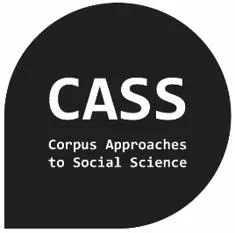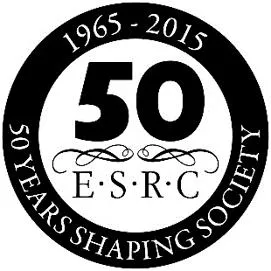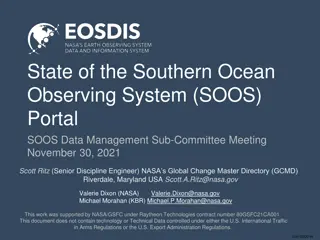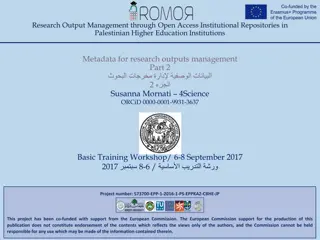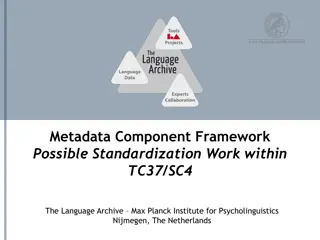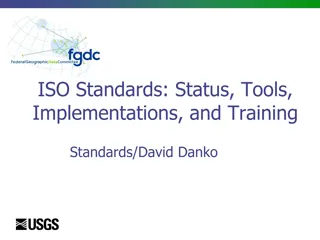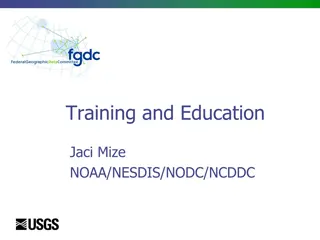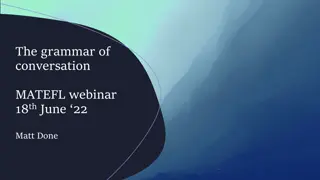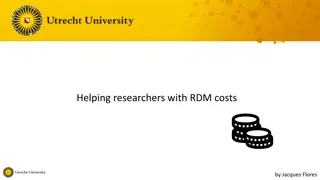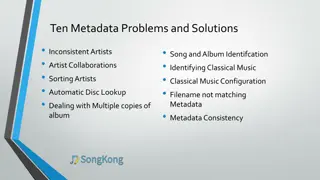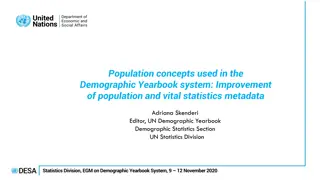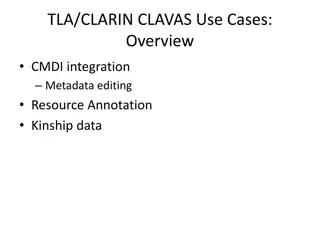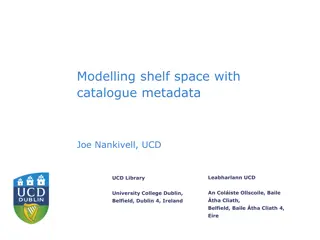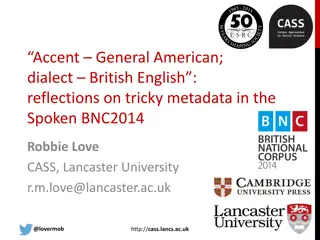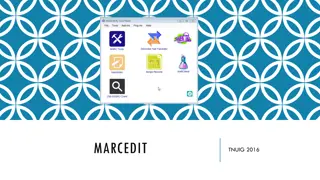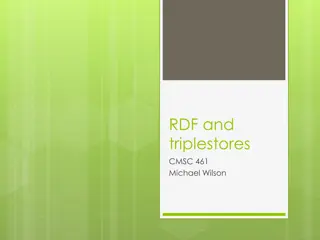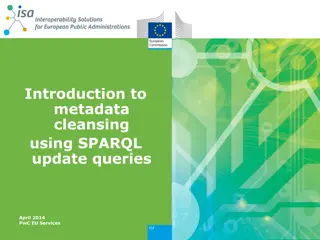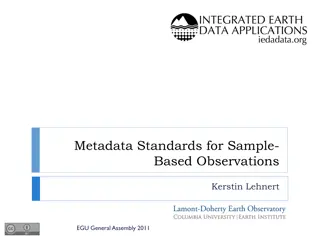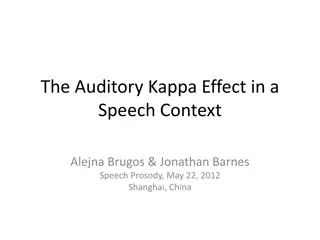Dealing with Metadata in the Spoken BNC2014: An Insightful Study
Delving into the metadata of the Spoken BNC2014, this study by Robbie Love at Lancaster University focuses on regional categorization, socio-economic status, and advancements towards dual compatibility with the BNC1994. With over 800 hours of recordings and nearly 700 unique speakers contributing to more than 10 million transcribed words, this project provides valuable insights into various demographic interactions and contexts captured over a 2-7 day period. The meticulous collection and analysis of metadata, including speaker details, recording information, and topics covered, offer a comprehensive overview of linguistic and social aspects revealed in the corpus.
Download Presentation

Please find below an Image/Link to download the presentation.
The content on the website is provided AS IS for your information and personal use only. It may not be sold, licensed, or shared on other websites without obtaining consent from the author. Download presentation by click this link. If you encounter any issues during the download, it is possible that the publisher has removed the file from their server.
E N D
Presentation Transcript
Normal with a brummy twang: dealing with metadata in the Spoken BNC2014 Robbie Love CASS, Lancaster University r.m.love@lancaster.ac.uk @lovermob http://cass.lancs.ac.uk
Todays talk 1. The Spoken BNC2014 2. Region 3. Socio-economic status 4. How far is too far? 5. Summary @lovermob http://cass.lancs.ac.uk 2
The Spoken BNC2014 Lancaster University + Cambridge University Press Both parties Fund project equally Encourage participation media campaigns Disseminate information CUP Corresponds with contributors Collects recordings Transcribes data Lancaster Documents the compilation of the corpus Carries out methodological investigations Converts transcripts to XML, encoding Annotates corpus Initial analysis Prepares for public release/hosts finished corpus @lovermob http://cass.lancs.ac.uk 3
So far Over 800 hours of recordings submitted (nearly 1000 recordings) Nearly 700 unique speakers More than 10 million words transcribed @lovermob http://cass.lancs.ac.uk 4
Recordings Spoken BNC 1994 Spoken BNC 2014 Interaction type Demographic (40%); Context-governed (60%) Demographic (100%) Who? Open call for participation; Some targeting Smartphone MP3 recordings Conversations; some task- based interactions. As determined by participant Carefully sampled individuals (Leech 1993:6) Tape recorders All interactions in a given period Continuously over a 2-7 day period 124 adults making recordings Over 1000 speakers ~10m words How? What? When? 668 unique speakers (so far) How many speakers? Total data 10m+ planned @lovermob http://cass.lancs.ac.uk 5
Metadata Spoken BNC 1994 Spoken BNC 2014 Speaker Age Gender Education Occupation Accent/dialect Socio-economic category Age Gender Education Occupation Accent/dialect Birthplace Linguistic origin Where do you currently live? How long have you lived there? Nationality Do you speak other languages? Title Date File name Recording length Recording location Speaker relationship Topics covered Recording Title Date Recording location @lovermob http://cass.lancs.ac.uk 6
Dealing with metadata Regional categorisation Socio-economic status Movement towards dual compatibility (with BNC1994 + modern approaches) Movement towards nominal categorisation with data-driven analysis How far is too far? Sexuality and religion @lovermob http://cass.lancs.ac.uk 7
Region the concept of dialect area as a fixed, tidy entity is ultimately a myth (Kortmann & Upton 2008: 25) Two approaches to analysing regional variation in corpus linguistics: (1) Pre-suppose metadata categories and compare contents (2) Data-driven: look at data and categorise Aim: facilitate (1) and encourage (2) @lovermob http://cass.lancs.ac.uk 8
Region Spoken BNC1994: Crowdy (1993: 260) Recording location (North/Midlands/South) Dialect/accent (32.9% speakers) @lovermob http://cass.lancs.ac.uk 9
Region What is region anyway? What are we trying to represent here? Birthplace? Recording location? Location of current residence? Location during acquisition? @lovermob http://cass.lancs.ac.uk 10
Region birthplace My place of birth bears absolutely no relation to how I speak because I wasn t brought up there; I was transported immediately somewhere else and brought up in a completely different place. But you wouldn t know that from the form. @lovermob http://cass.lancs.ac.uk 11
Region recording location Recordings are not just made in the speakers home Holidays, visiting friends/family etc Location of recording may have no sociolinguistic relationship to speaker @lovermob http://cass.lancs.ac.uk 12
Region location of current residence Chambers (1992: 680): dialect acquirers make most of the lexical replacements they will make in the first two years Unreliable where is the line? Temporary idiolect features new relationships, friendships etc. @lovermob http://cass.lancs.ac.uk 13
Region location during acquisition Stanford (2008: 567): even though childhood language acquisition takes place in the midst of a highly variable input , it is the time where coherent linguistic identity is formed But Like birthplace people move around Location linguistic identity? @lovermob http://cass.lancs.ac.uk 14
Region Purely objective metadata seems insufficient Subjective metadata offers an imperfect solution: Self-reported dialect British Library s Evolving English WordBank (2011) E.g. Geordie = north east England @lovermob http://cass.lancs.ac.uk 15
Self-reported dialect categorisation Central midlands, north-east midlands, midlands, south midlands, north-west midlands southern normal with a brummy twang mixed northern/somerset/rp @lovermob http://cass.lancs.ac.uk 16
Dialect categorisation BNC1994: it s a mess Office for National Statistics scheme: Nomenclature of Territorial Units for Statistics (NUTS) Used in the census (ONS 2013) (1) North East (2) North West (3) Merseyside (4) Yorkshire & Humberside (5) East Midlands (6) West Midlands (7) Eastern (8) London (9) South East (10) South West (11) Wales (12) Scotland (13) Northern Ireland @lovermob http://cass.lancs.ac.uk 17
Dialect in the Spoken BNC2014 (1) Global (2) Country (3) Supra-region (4) Region UK England North North East Yorkshire & Humberside North West (not Merseyside) Merseyside Midlands East Midlands West Midlands Comparable with Spoken BNC1994 too! South Eastern South West South East (not London) London Scotland Scotland Scotland Wales Wales Wales Northern Ireland Northern Ireland Northern Ireland Non-UK Republic of Ireland Republic of Ireland Republic of Ireland Other non-UK variety Other non-UK variety Other non-UK variety Unspecified Unspecified Unspecified Unspecified @lovermob http://cass.lancs.ac.uk 18
Dialect in the Spoken BNC2014 @lovermob http://cass.lancs.ac.uk 19
Geordie (1) Global (2) Country (3) Supra-region (4) Region UK England North North East Yorkshire & Humberside North West (not Merseyside) Merseyside Midlands East Midlands West Midlands South Eastern South West South East (not London) London Scotland Scotland Scotland Wales Wales Wales Northern Ireland Northern Ireland Northern Ireland Non-UK Republic of Ireland Republic of Ireland Republic of Ireland Other non-UK variety Other non-UK variety Other non-UK variety Unspecified Unspecified Unspecified Unspecified @lovermob http://cass.lancs.ac.uk 20
Southern (1) Global (2) Country (3) Supra-region (4) Region UK England North North East Yorkshire & Humberside North West (not Merseyside) Merseyside Midlands East Midlands West Midlands South Eastern South West South East (not London) London Scotland Scotland Scotland Wales Wales Wales Northern Ireland Northern Ireland Northern Ireland Non-UK Republic of Ireland Republic of Ireland Republic of Ireland Other non-UK variety Other non-UK variety Other non-UK variety Unspecified Unspecified Unspecified Unspecified @lovermob http://cass.lancs.ac.uk 21
Normal with a brummy twang (1) Global (2) Country (3) Supra-region (4) Region UK England North North East Yorkshire & Humberside North West (not Merseyside) Merseyside Midlands East Midlands West Midlands South Eastern South West South East (not London) London Scotland Scotland Scotland Wales Wales Wales Northern Ireland Northern Ireland Northern Ireland Non-UK Republic of Ireland Republic of Ireland Republic of Ireland Other non-UK variety Other non-UK variety Other non-UK variety Unspecified Unspecified Unspecified Unspecified @lovermob http://cass.lancs.ac.uk 22
Mixed northern/somerset/rp (1) Global (2) Country (3) Supra-region (4) Region UK England North North East Yorkshire & Humberside North West (not Merseyside) Merseyside Midlands East Midlands West Midlands South Eastern South West South East (not London) London Scotland Scotland Scotland Wales Wales Wales Northern Ireland Northern Ireland Northern Ireland Non-UK Republic of Ireland Republic of Ireland Republic of Ireland Other non-UK variety Other non-UK variety Other non-UK variety Unspecified Unspecified Unspecified Unspecified @lovermob http://cass.lancs.ac.uk 23
Evaluating this approach Montgomery (2012) we aren t very good at judging dialect boundaries reliably perceptual dialectology One speaker s southern might be another speaker s midlands Requires some inference i.e. a subjective metadata set Contradictions in speaker reports But More reliable method than BNC1994 speak for yourself! The best we can get for a top-down scheme @lovermob http://cass.lancs.ac.uk 24
Regional distribution so far 600000 500000 400000 300000 200000 100000 0 @lovermob http://cass.lancs.ac.uk 25
Socio-economic status Assumption: to rank according to socio- economic status = ordinal My aim: encourage nominal use and allow data to do the talking (pun intended) @lovermob http://cass.lancs.ac.uk 26
BNC1994: Social Grade Code Description A Higher managerial, administrative and professional B Intermediate managerial, administrative and professional C1 Supervisory, clerical and junior managerial, administrative and professional C2 Skilled manual workers D Semi-skilled and unskilled manual workers E State pensioners, casual and lowest grade workers, unemployed (NRS 2014) with state benefits only Dominant in market research (Collis 2009) Few categories = low detail Category E particularly problematic @lovermob http://cass.lancs.ac.uk 27
NS-SEC Class Analytic class 1 Higher managerial, administrative and professional occupations Large employers and higher managerial and administrative 1.1 occupations 1.2 Higher professional occupations 2 Lower managerial, administrative and professional occupations 3 Intermediate occupations 4 Small employers and own account workers 5 Lower supervisory and technical occupations 6 Semi-routine occupations 7 Routine occupations 8 Never worked and long-term unemployed (ONS 2010) * Students/unclassifiable Government standard 2001-present More categories than Social Grade Nominal: ordinality should not be assumed and analyses should be performed by assuming nominality (Rose & O Reilly 1998: 4) Automatic coding from occupation = consistency @lovermob http://cass.lancs.ac.uk 30
Socio-economic status Decision Code using NS-SEC from occupation Automatic mapping from NS-SEC -> Social Grade for backwards compatibility with BNC1994 Plan: attempt to retrofit the old data onto NS- SEC for two-way comparison @lovermob http://cass.lancs.ac.uk 31
Mapping NS-SEC onto Social Grade NS-SEC Description SG Description Higher managerial, administrative and professional occupations 1 A Higher managerial, administrative and professional Large employers and higher managerial and administrative occupations 1.1 1.2 Higher professional occupations B Intermediate managerial, administrative and professional Lower managerial, administrative and professional occupations MAPS ON TO 2 C1 Supervisory, clerical and junior managerial, administrative and professional 3 Intermediate occupations 4 Small employers and own account workers C2 Skilled manual workers 5 Lower supervisory and technical occupations D Semi-skilled and unskilled manual workers 6 Semi-routine occupations 7 Routine occupations E State pensioners, casual and lowest grade workers, unemployed with state benefits only 8 Never worked and long-term unemployed * Students/unclassifiable @lovermob http://cass.lancs.ac.uk 32
Socio-economic status distribution so far 1600000 1400000 1200000 1000000 800000 600000 400000 200000 0 1.1 1.2 2 3 4 5 6 7 8 Uncat Unknown @lovermob http://cass.lancs.ac.uk 33
Socio-economic status distribution so far 1600000 1400000 1200000 1000000 800000 600000 400000 200000 0 A B C1 C2 D E Unknown @lovermob http://cass.lancs.ac.uk 34
Socio-economic status distribution (BNC1994) 2500000 2000000 1500000 1000000 500000 0 AB C1 C2 DE Unknown Info missing @lovermob http://cass.lancs.ac.uk 35
How far is too far? Pilot stage (30 speakers) some new categories dropped Why? Many speakers refused to answer Sexuality 17/30 [prefer not to say] Religion 16/30 [prefer not to say] @lovermob http://cass.lancs.ac.uk 36
How far is too far? I wasn t quite sure why you needed to know sexual preference on there, but I suppose if you re looking at how different factions use language and differences in language then that could be important. There was some discussion about why you needed to know things like sexuality and religion. And some people said prefer not to say. @lovermob http://cass.lancs.ac.uk 37
How far is too far? 17/30 disclosed sexuality 2/17 [homosexual] A very large corpus would be required to overcome this difference in order to compare language of different sexualities @lovermob http://cass.lancs.ac.uk 38
Summary Self-reported speaker dialect > objective categories Social Grade is outdated NS-SEC gives new life to new and old data Both need to be defined clearly Balance between comparability & improvement & representativeness Top-down categorisation is crucial, but limited, & new schemes should emerge from the data Even though not ideal, we do have to be sensitive to speaker perceptions of the research No one corpus can serve every imaginable purpose and that s okay! @lovermob http://cass.lancs.ac.uk 39
References British Library. (2011). Evolving English WordBank. Accessed 07 June 2016 at: http://sounds.bl.uk/Accents-and-dialects/Evolving-English-WordBank/ Chambers, J.K. (1992). Dialect Acquisition. Language, 68(4): 673-705. Collis, D. (2009). Social Grade: A Classification Tool. Retrieved 06 January 2015 from Ipsos MediaCT: https://www.google.co.uk/url?sa=t&rct=j&q=&esrc=s&source=web&cd=1&ved=0ahUKEwiSlL7VjJXKAhUGiRoKHUahA0oQFggsMAA&url=https%3A%2 F%2Fwww.ipsos- mori.com%2FDownloadPublication%2F1285_MediaCT_thoughtpiece_Social_Grade_July09_V3_WEB.pdf&usg=AFQjCNFYK_7QUoBKdeQhxFj6M8E2v 8iplA&sig2=7ta53WYV0K9JufBZgLcYhw&cad=rja Crowdy, S. (1993). Spoken Corpus Design. Literary and Linguistic Computing, 8(4), 259-265. Kortmann, B. and Upton, C. (2008) Introduction: varieties of English in the British Isles. In Kortmann, B. and Upton, C. (eds.) Varieties of English: The British Isles. Berlin: Mouton de Gruyter. Pp. 23-32. Montgomery, C. (2012), The effect of proximity in perceptual dialectology. Journal of Sociolinguistics, 16: 638 668. doi: 10.1111/josl.12003 NRS. (2014). Social Grade. Retrieved January 04, 2016, from National Readership Survey: http://www.nrs.co.uk/nrs-print/lifestyle-and-classification- data/social-grade/ Office for National Statistics. (2010c). The National Statistics Socio-economic Classification (NS-SEC rebased on the SOC2010). Retrieved December 12, 2013, from Office for National Statistics: http://www.ons.gov.uk/ons/guide-method/classifications/current-standard- classifications/soc2010/soc2010-volume-3-ns-sec--rebased-on-soc2010--user-manual/index.html Office for National Statistics. (2013). Region and Country Profiles, Key Statistics, December 2013. Accessed 05 February 2015 at: http://www.ons.gov.uk/ons/publications/re-reference-tables.html?edition=tcm%3A77-337674 Rose, D. & O Reilly, K. (1998). The ESRC Review of Government Social Classifications. London & Swindon: Office for National Statistics & Economic and Social Research Council. Retrieved 05 January 2016 from the Office for National Statistics: http://www.ons.gov.uk/ons/guide- method/classifications/archived-standard-classifications/soc-and-sec-archive/esrc-review/index.html Rose, D. & Pevalin, D.J. (with O Reilly, K.). (2005). The National Statistics Socio-economic Classification: Origins, Development and Use. Houndsmills: Palgrave Macmillan. Retrieved 05 January 2016 from the Office for National Statistics: http://www.ons.gov.uk/ons/guide- method/classifications/archived-standard-classifications/soc-and-sec-archive/index.html Stanford, J. (2008). Child dialect acquisition: New perspectives on parent/peer influence. Journal of Sociolinguistics, 567-596. Stuchbury, R. (2013a). Other classifications: SEG. Retrieved 06 January 2015 from the Centre for Longitudinal Study Information and User Support (CeLSIUS): https://www.ucl.ac.uk/celsius/online-training/socio/se050000 Stuchbury, R. (2013b). Social class (SC). Retrieved 06 January 2015 from the Centre for Longitudinal Study Information and User Support (CeLSIUS): https://www.ucl.ac.uk/celsius/online-training/socio/se040100 @lovermob http://cass.lancs.ac.uk 40
r.m.love@lancaster.ac.uk @lovermob @lovermob http://cass.lancs.ac.uk 41




